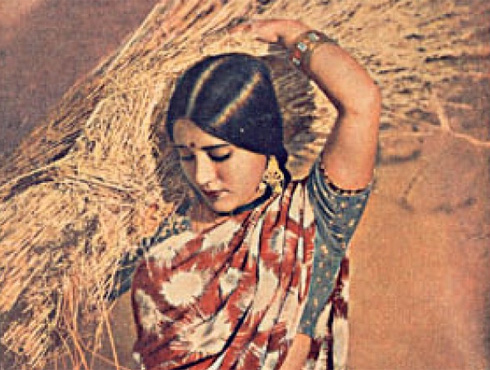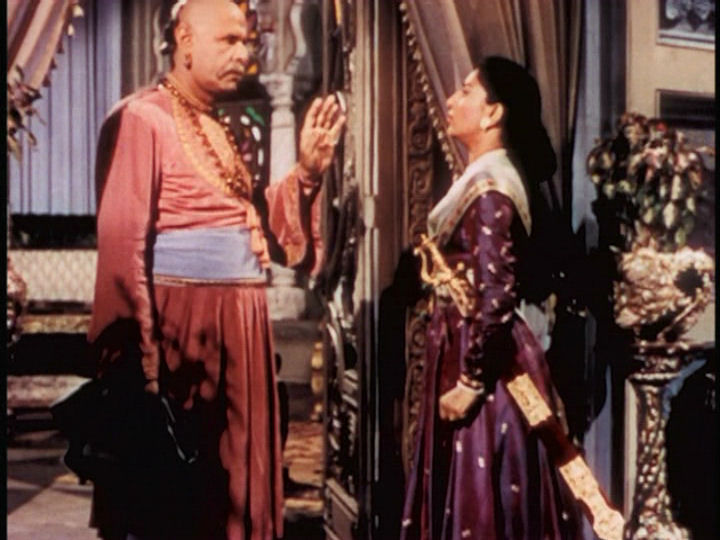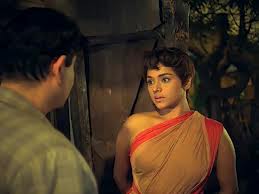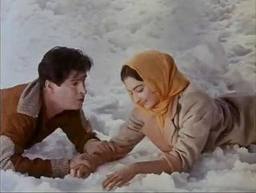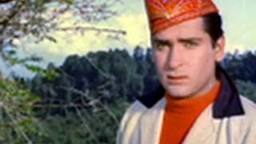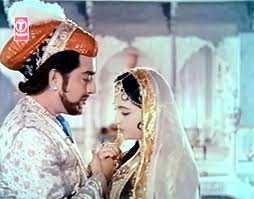Colour films in Hindi-Urdu
(→Colour films gradually edge out black and white) |
(→Colour films gradually edge out black and white) |
||
| Line 28: | Line 28: | ||
===Colour films gradually edge out black and white=== | ===Colour films gradually edge out black and white=== | ||
[[File:guide.jpg|Dev Anand (seen above with Waheeda Rehman) used Pathecolour in his own Guide (1965). His admirer Amit Khana resurrected Pathecolour in the Dev-starrer Man Pasand (197?)|frame|500px]] | [[File:guide.jpg|Dev Anand (seen above with Waheeda Rehman) used Pathecolour in his own Guide (1965). His admirer Amit Khana resurrected Pathecolour in the Dev-starrer Man Pasand (197?)|frame|500px]] | ||
| − | The megastar of the 1950s and the early ’60s, Dilip Kumar, did not act in a black and white film after 1961; the highest paid star of the mid-1960s, Rajendra Kumar, followed suit. By the late 1960s the only black and white films featuring major actors were serious films meant for arthouses (e.g. the Raj Kapoor starrer Teesri Qasam/ 1967 and the Nargis-starrer Raat Aur Din/ 1967) or those that had got delayed in the making. | + | The megastar of the 1950s and the early ’60s, Dilip Kumar, did not act in a black and white film after 1961; the highest paid star of the mid-1960s, Rajendra Kumar, followed suit. By the late 1960s the only black and white films featuring major actors were serious films meant for arthouses (e.g. the Raj Kapoor starrer Teesri Qasam/ 1967 and the Nargis-starrer Raat Aur Din/ 1967) or those that had got delayed in the making. |
| − | Shammi Kapoor is the star associated with the introduction of Eastmancolor in India but even he had | + | |
| + | Shammi Kapoor is the star associated with the introduction of Eastmancolor in India but even he had an A-category commercial black and white film Budtameez as late as in 1966. The Dev Anand starrer Kahin Aur Chal (1968) was perhaps the last A-list commercial Hindi-Urdu film in black and white. | ||
| + | |||
Black and white continued into the early 1970s, with art films like Dastak (1970) and Ashad Ka Ek Din (1971). | Black and white continued into the early 1970s, with art films like Dastak (1970) and Ashad Ka Ek Din (1971). | ||
Revision as of 10:42, 28 April 2013
Contents |
India
India
Hindi-Urdu
Kisan Kanya, India’s first colour film
Kisan Kanya (lit: the peasant girl; 1937/ Dir: Moti B. Gidvani; prod. Ardeshir Irani) was arguably India’s first colour film. This story about rural poverty did not go down well with mass audiences, so colour films did not catch the public imagination—till Aan (1953).
Aan, the first Indian film in Technicolor
The Dilip Kumar, Nimmi starrer by Mehboob Khan, the first Indian film in Technicolor, was shot in 16 mm and later blown up to 35 mm. It was a landmark success. V. Shantaram’s Jhanak Jhanak Payal Baaje (1955), too, Mehboob Khan’s Mother India (1957) and V. Shantaram’s Navrang (1959), too, were the biggest hits of their respective years. Only Sohrab Modi’s lavishly produced Technicolor Jhansi Ki Rani (1956) fared badly at the box office.
Technicolor’s run of success continued into the 1960s, but not as triumphantly. Gunga Jamuna, Mere Mehboob and Sangam were, again, the biggest hits of their respective years. But Son of India, Leader, Palki and Mera Naam Joker tanked.
So, Technicolor was no longer a guarantor of success. Besides, Technicolor’s parent company had launched Eastmancolor.
Eastmancolor
Junglee (1961) was the first Indian film in Eastmancolor, a colour technology made by the same company as Technicolor, but was less complex and, therefore, less expensive. On the other hand Eastmancolor was vastly more satisfying than the even cheaper Gevacolor and Orwocolor.
Eastmancolor films after Junglee included Professor and Taj Mahal (both 1963). By the mid-1960s Hindi-Urdu audiences started demanding colour. Dosti, a low budget weepie that touched the nation’s hearts (1964) and Saheli (1965) were, arguably, the last hits in black and white.
Colour films gradually edge out black and white
The megastar of the 1950s and the early ’60s, Dilip Kumar, did not act in a black and white film after 1961; the highest paid star of the mid-1960s, Rajendra Kumar, followed suit. By the late 1960s the only black and white films featuring major actors were serious films meant for arthouses (e.g. the Raj Kapoor starrer Teesri Qasam/ 1967 and the Nargis-starrer Raat Aur Din/ 1967) or those that had got delayed in the making.
Shammi Kapoor is the star associated with the introduction of Eastmancolor in India but even he had an A-category commercial black and white film Budtameez as late as in 1966. The Dev Anand starrer Kahin Aur Chal (1968) was perhaps the last A-list commercial Hindi-Urdu film in black and white.
Black and white continued into the early 1970s, with art films like Dastak (1970) and Ashad Ka Ek Din (1971).
Art films have been in colour since at least Satyajit Ray’s Kanchanjangha (1962/ Bengali/ Eastmancolor), but then India’s greatest maestro had the world as his market. Even he did not get back to an entirely-in-colour film for another 11 years, till 1973 (Ashani Sanket), after which he never went back to black and white.
In Hindi-Urdu cinema, too, art films had been made in colour since Chetna (1970). However, it was Blaze films’ Eastmancolor Ankur (The Seedling) (1974), lavishly produced by the standards of Indian art cinema, that announced that art films need not be micro-budget. After that no Hindi-Urdu film, not even an art film, was made in black and white.
